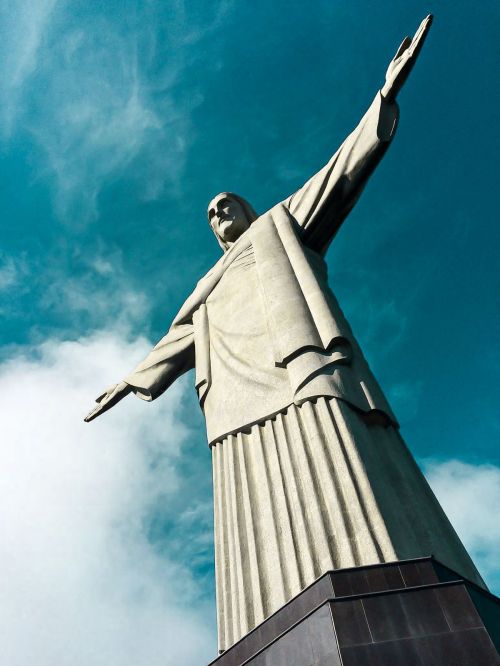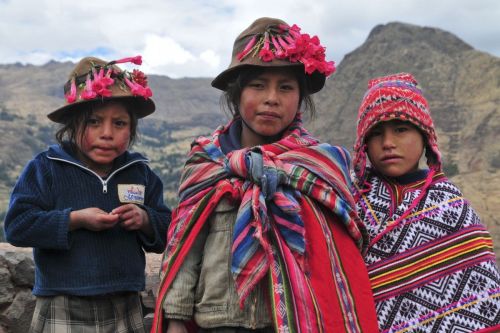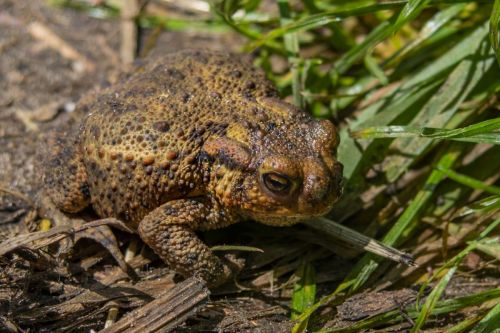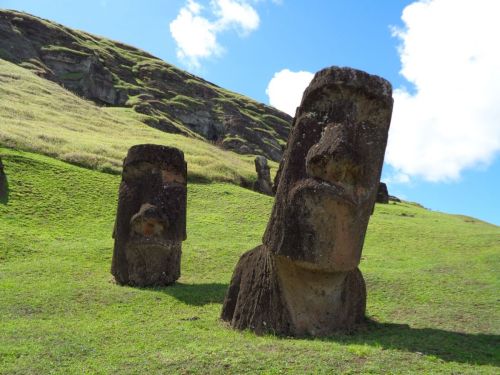Brazil is the largest and most populous country in South America and one of the largest and most populous countries in the world. A former Portuguese colony, it is the largest country, with Portuguese as its official language and the only language in the Americas. It is also one of the most multicultural and ethnically diverse nations, due to more than a century of mass immigration from around the world. It is also the country with the largest population of Catholics in the world.
It is the largest country in both South America and Latin America.
It occupies most of the eastern part of the South American continent and its geographic center, as well as various islands in the Atlantic Ocean.
It has the Fernando de Noronha archipelago, and several small islands and atolls in the Atlantic - Abrolhos, Atol das Rocas, Penedos de Sao Pedro e Sao Paulo, Trindade, and Martim Vaz.
It borders Uruguay to the south, Argentina and Paraguay to the southwest, Bolivia, and Peru to the west, Colombia to the northwest, and Venezuela, Guyana, Suriname, and French Guiana to the north.
It is also the only country in the world through which the equator and the Tropic of Capricorn run.
The westernmost is equivalent to Eastern Standard Time in the United States.
- Amazon basin - a system of tropical rainforests
- Pantanal - the world's largest tropical wetlands and the world's largest flooded grasslands
- Cerrado - a vast tropical savanna ecoregion, covering much of the center of the country
- Caatinga - a region of subtropical vegetation, thorny scrubland in the northeast
- Mata Atlantica (Atlantic Forest) - stretching along the entire coast from northeast to south
- Pampas - the fertile lowland plains of the far south
Ocean waters lap the country's territory from the northeast and southeast. The northern part of the coast is disjointed, and there are estuaries of rivers. There is the mouth of the Amazon River and the largest river island of this estuary - Marajo - which is also the largest island surrounded by fresh water.
In the northern part of the coast, in many places, there are coral reefs.
Much of the terrain lies at elevations ranging from 2000 m to 800 m. The main highland area occupies most of the south of the country. The northwestern parts of the plateau consist of wide, undulating terrain with low rounded hills.
In the southeastern part of the country, there are mountain ranges reaching heights of up to 1200 meters. These ranges include the Mantiqueira, Espinhaco, and Serra do Mar mountains.
Brazil's highest peak is Pico da Neblina, 2995,3 meters above sea level, in Serra da Neblina, part of the Highlands of Guyana.
The main rivers are the Amazon River, the second longest (according to some, the longest in the world) and the largest in terms of water volume, Paraná and its main tributary, the Iguacu (including Iguazu Falls), Rio Negro, Sao Francisco, Xingu, Madeira, and Tapajos.
They are the waterfalls of the Iguazu River on the border of the Argentine province of Misiones and the Brazilian state of Paraná. Only 20% of the waterfall area is located in Brazilian territory, and 80% lies in Argentine territory.
The waterfall is stair-stepped. Its width is about 2 km and it consists of 275 separate rockfalls. The largest cascade, called Devil's Throat, is located on the Argentine-Brazilian border. The water here falls from 82 meters - a height greater than Niagara Falls (50 meters).
The different climatic conditions create different environments, ranging from equatorial rainforests in the north and deserts in the northeast to temperate coniferous forests in the south and tropical savannas in central Brazil.
It has the most known species of plants (55.000), freshwater fish (3000), and mammals (more than 689). It ranks third on the list of countries with the most bird species (1832) and second with the most reptile species (744).
Brazil is the second country with the most endemic species after Indonesia.
Scientists estimate that the total number of plant and animal species in Brazil may approach four million, mostly invertebrates. Brazil has the largest number of both terrestrial vertebrates and invertebrates of any country in the world. It has many thousands of species, many (if not most) of which are still undiscovered.
The larger mammals found there are carnivores: pumas, jaguars, ocelots, the rare bush dogs and foxes, and herbivores: peccaries, tapirs, anteaters, sloths, opossums, and armadillos.
Northern rainforests abound with many species of New World monkeys.
Extensive logging of national forests, especially the Amazon, both official and unofficial, is destroying areas the size of a small country every year, as well as a diversity of plant and animal species.
More than one-fifth of Brazil's Amazon rainforest has been destroyed, and more than 70 mammals are endangered (deforestation and poaching). In the Atlantic Forest, nearly 93% of the forest has been cleared. Of the 202 endangered animals in Brazil, 171 are in the Atlantic Forest.
It is also the ninth-largest economy in the world and eighth in terms of purchasing power parity. It is characterized by many rich natural resources.
It is a major exporter of soybeans, iron ore (the world's second-largest exporter), cellulose, corn, beef, poultry meat, soybean meal, sugar, coffee, tobacco, cotton, orange juice, shoes, airplanes, automobiles, auto parts, gold, ethanol, semi-finished iron, among others.
It is the largest producer of various agricultural commodities and has a large cooperative sector that supplies 50% of the country's food. The world's largest health cooperative, UNIMED, is located in Brazil and accounts for 32% of the country's health insurance market.
It is one of the major producers of tourmaline, emerald, aquamarine, and garnet.
The Itaipu Dam (a dam on the Parana River, located on the border between Brazil and Paraguay) is the world's largest hydroelectric plant in terms of energy production.
The first car with an ethanol engine was produced there in 1978, and the first ethanol-powered aircraft engine in 2005.
In 2020, Brazil was the second largest country in the world in terms of biomass energy production (energy production from solid biofuels and renewable waste).
The Brazilian Catholic Church is the largest national community of believers in the world. Catholics there currently make up about 63% of the population, but the number of regular practitioners is estimated at 19-25%.
Recently, there has been an outflow of the faithful to communities mainly from the US, such as Jehovah's Witnesses, Mormons (about 1 million) Adventists, and various evangelical churches (such as Pentecostals).
This is the second largest number of airports in the world, after the United States. The largest are Sao Paulo- Guarulhos Airport, Rio de Janeiro-Galeao Airport, Brasilia Airport, and others.
Of these, 215.000 kilometers are paved roads, and about 14.000 kilometers are highways and other dual carriageways. Brazil's rail network has a total length of about 30.000 kilometers. There are also busy water ports.
Not much is known about these cultures, only that, unlike the Indians of the West Coast, they did not develop a material heritage. They were largely nomadic tribes.
The place where the sailors went ashore is now called Porto Seguro (safe harbor) and is located in the state of Bahia. The first whites to be forcibly settled were two convicts left there by Cabral to assimilate with the natives.
The first Portuguese settlers arrived in Santa Cruz in 1501. They included poor people, but also nobles who were allotted vast tracts of land - many of these huge estates are the current Brazilian states.
Brazil was colonized by Portugal for 300 years.
At the time, the country was reaping huge profits from the exploitation of the pith of the Caesalpinia echinata and Caesalpinia brasiliensis trees, which contained a red dye called brazilin, used in weaving.
The labor needed was obtained from among the captured indigenous population. Sugar cane plantations brought to Brazil from Madeira and Cape Verde were also established. Indians who were unsuitable for hard physical labor died en masse, so black slaves from Africa began to be brought to Brazil.
An important missionary was Joseph Anchieta, who carried out his mission in Brazil for 44 years. He was proclaimed an Apostle of Brazil, in 1980 Pope John Paul II confirmed the title and beatified Anchiete, and in 2014 Pope Francis included him among the saints.
Since 1965, his evangelization work has been remembered in Brazil on June 9 (Anchiete Day).
Bandeirantes - armed adventurers who also engaged in the Indian slave trade - then appeared. In the 18th century, cotton cultivation was introduced there.
The city was founded on the site where Amerigo Vespucci came ashore in 1501. Salvador was founded in 1549 by Tome de Sousa. By 1650 Salvador was the largest metropolis in the southern hemisphere. The city's boom ended when the capital was moved to Rio de Janeiro in 1763.
Portugal officially recognized Brazil on August 29, 1825. The monarchy, on the other hand, was overthrown by a military coup on November 15, 1889, and the day is now a national holiday, Republic Day.
At the turn of the 20th century, more than five million immigrants from Europe and Asia arrived in Brazil.
The royal family headed by John VI (King of Brazil and Portugal) took refuge there from invading Napoleonic troops.
It is the third (after Sao Paulo and Rio de Janeiro) most populous city in the country. Brasilia became the capital on April 21, 1960. The city is built on a plan referring to a flying condor or airplane.
Brasilia's architecture, characterized by futuristic buildings made of steel, glass, marble, and concrete, is considered an example of a masterpiece of 20th-century modernism and has been included in UNESCO's International Cultural Heritage List.












